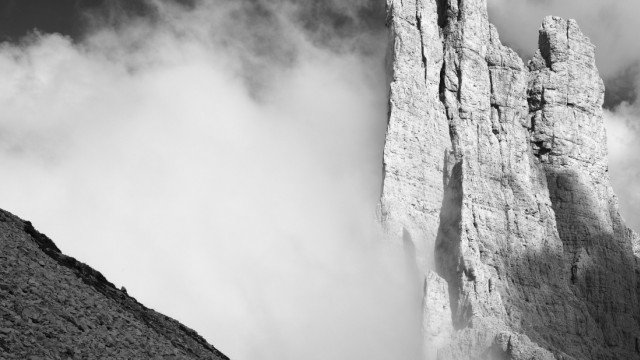The Matterhorn. An ideal mountain. If children are asked to paint a mountain, they will almost certainly come up with the shape of the Matterhorn – an acute triangle or, in three dimensions, a pointed, fairly even pyramid. Free-standing, often photographed against a bright blue sky, images of the Matterhorn usually have an emblematic character: the essence of the word mountain is always visible.
The photographer Peter Mathis has chosen a different visual language. Two photos of the Matterhorn can be found in his photo book with the simple title “Mountains”. In both – and in very different ways – Mathis takes away the burden of not only having to stand alone, but also always having to represent the entire mountain as a whole. In the first photograph, a cloud wraps around his massive body like a billowing dress, concealing his contours. Only the summit part is visible. At the very top, on one flank, a second cloud is caught. As if the summit was burning and clouds of smoke were rising into the sky. Or as if he were wearing a daring headdress to match the cloud dress.
In the second photograph the mountain dissolves, especially the summit area becoming almost one with the gray sky behind it. You can only see exposed rock very faintly. In this picture, the Matterhorn is not a manifestation of a mountain, but merely an inkling of it. As if it were a fragile, quickly transitory, extremely delicate structure.
Silvretta and Rätikon, the border region between Austria and Switzerland.
(Photo: Peter Mathis/Prestel Verlag)
Peter Mathis is all about taking pictures that have never been seen before. A very ambitious claim, especially in this day and age when you think you’ve seen everything before. But Mathis often redeems it, especially when you already know the basic motif of his pictures. This also has to do with the fact that Mathis from Vorarlberg, himself an excellent mountaineer, switched to black and white photography many years ago. He doesn’t need the best lighting conditions, but rather moments of strong contrast. That’s not the same.
There are shots where the deepest black and the brightest white collide. For example, in a photograph of the Salbit Bridge in the Uri Alps. In the foreground, coniferous trees stand in the shadows like silhouettes, recognizable only by their outlines, not by a structure made up of trunk, branches, twigs and needles. And behind the footbridge, which stretches spectacularly over a precipice, the rock glitters as if it were a large piece of chalk. Then again you see images that do not drift into these extremes, but instead show delicate yet clearly distinguishable gradations of gray tones, almost like geometric patterns, for example at Half Dome in the Sierra Nevada.

The Vajolet towers in the Dolomites.
(Photo: Peter Mathis/Prestel Verlag)
A seemingly simple image structure often creates the impression of a special dynamic and drama. Using the example of the Vajolet towers in the Dolomites and the rocky island of Tindhólmur on the Faroe Islands, Mathis explains in short accompanying texts how essential the search for the perfect vantage point is. So that the gravel level slopes down at a favorable angle in front of the rock towers or the silhouette of the rock island stands out in a particularly eye-catching way. And then you need patience until a bank of fog rolls in or light falls on the water so that the composition is absolutely harmonious.

The rocky island of Tindhólmur is part of the Faroe Islands.
(Photo: Peter Mathis/Prestel Verlag)
That’s why Peter Mathis doesn’t care how prominent the mountains are or how high. He is interested in fascinating combinations of rock, snow, ice, water, clouds and fog. He finds them in Scandinavia as well as in the Elburz Mountains, in the Karwendel as well as in the Mont Blanc massif. In a few pictures, the rock alone is in the foreground because of a particularly remarkable mountain fold that can be seen on the surface there. Mathis shows some examples from the Appenzell Alps, such as the Altenalptürm or the Schäfler.
These photographs in particular reveal a special quality of Peter Mathis’ work: a particular sharpness of the images. As a result, Mathis achieves a level of detail that can only be found in a few other alpine photographers. The mountains become particularly three-dimensional, creating an impression not only of image depth, but actually of three-dimensionality.
And you can see something else in the pictures: that what you see in them could only be seen at the moment Mathis triggered his camera. Five minutes earlier or two days later the scene would be different. And a shot of it might still be a good photo. But not outstanding, not unique. And anyone who goes about their work with such meticulousness will inevitably be rewarded with eleven mountain jackdaws in the air appearing to be models for them.
Peter Mathis: Mountains. Prestel Verlag, Munich, London, New York 2023. 176 pages, 59 euros

